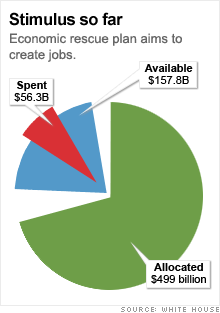Stimulus: Progress or broken promise?
As the economy continues to get worse, many wonder if stimulus is big and fast enough. But the White House says it's too early to judge.

NEW YORK (CNNMoney.com) -- Nearly five months after President Obama signed the $787 billion stimulus bill, a still-worsening economy has many wondering if stimulus is a bunch of baloney.
In February, Obama promised that funds would be paid out quickly and save or create 750,000 jobs by early August.
Further, the boost to the economy would keep the unemployment rate from surpassing 8%, according to a January study by Obama administration economists Christina Romer and Jared Bernstein. Without it, the study said, unemployment could rise to 9% in 2010.
With August quickly approaching, roughly $75 billion, or 10% of stimulus funds, have been paid out, and the unemployment rate has already risen to 9.5%.
As a result, there's debate about whether stimulus has put the economy on a path to recovery or is merely a broken promise. Some economists are already calling for a second stimulus bill as the economy continues to falter, arguing the stimulus wasn't strong enough and isn't being paid out fast enough.
On the other hand, many Republicans and even some Democrats are saying that parts of the plan were a waste of money.
"This form of fiscal stimulus will have no meaningful effect on the economy whatsoever, because they don't have a magic wand to create purchasing power," said J.D. Foster, economic fellow at the conservative-leaning Heritage Foundation. "Even if you do think stimulus is effective, what they're arguing is $56 billion is really effective. This is pure spin."
But a number of experts say stimulus is working, only its successes have been obscured by a worse-than-expected economy.
"The stimulus package is helping with job creation, but the job loss has been a lot bigger than the administration envisioned," said Dean Baker, co-director of the Center for Economic and Policy Research. "What they inherited was worse than they thought -- we'll probably be going over 10% in the fall."
The Obama administration estimated that the stimulus package helped to create or save 150,000 jobs in the administration's first 100 days, and will save or create 500,000 in its second hundred days, ending in early August. Still, that's little help to an economy that has shed an average of 490,000 jobs per month, totaling 2 million lost jobs since the stimulus bill's signing.
Though the White House conceded that the economy has turned out to be much worse than it anticipated, it cautioned people not to give up on stimulus just yet.
"We misread how bad the economy was, but we are now only about 120 days into the recovery package," said Vice President Joseph Biden in an interview on ABC's "This Week" on Sunday. "The truth of the matter was no one expected that that recovery package would in fact be in a position at this point of having distributed the bulk of the money."
"The pace of the ball is now going to increase," Biden added.
Still a long way to go: Of the $787.2 billion in American Recovery and Reinvestment Act funds, $499 billion is for stimulus projects, of which $157.8 billion has been made available and $56.3 billion has been spent. The biggest chunk, $22 billion, has been spent by states for Medicare and Medicaid payments.
The other $288 billion is for tax relief. The bill, starting March 1, eased burdens on some people receiving unemployment benefits, Cobra health insurance and food stamps.
The high-profile tax measure was the $116 billion Making Work Pay tax credit that began appearing in workers' paychecks on April 1.
The Joint Committee on Taxation did not have exact figures for how much in tax relief has been withheld so far, but estimated a total of about $20 billion.
"It's just not fast enough," said Bob Brusca, economist with FAO Economics. "There's a lot of political agenda associated with stimulus, on top of the fact that the economy is clearly in worse shape than administration thought."
Part of the reason stimulus has been slow-going so far is the number of hurdles projects need to clear before money gets out the door. Projects need to meet certain guidelines, as the government seeks to ensure that the money is spent wisely.
For instance, the electronic health record program has been allocated $20 billion, but the Health Department will not pay out the funds until October 2010 -- until hospitals and physicians can demonstrate that they are using the records meaningfully.
"Typically, projects chase money, but stimulus has created a situation where money is chasing projects," said Tim Dowd, chief executive of Input, a consulting firm that provides information about government contracts. "States and companies are still struggling to determine what infrastructure and overhead they need to meet government requirements."
Still, Dowd believes the government will ultimately meet its spending targets, ramping up its spending toward the end of the year as states fund projects that can spend the money quickly.
The Obama administration agrees, saying it is on pace to reach its goal of spending 70% of the money by September 2010. But it said the true measure of stimulus is whether or not the economy shows sustained improvement.
"We are working both to get people to work quickly, and lay a long-term foundation for sustainable economic growth," said Liz Oxhorn, White House spokeswoman for the Recovery Act. "We won't be satisfied until we see job growth, but we are already seeing some early signs of progress and it's clear our current economic situation would have been much more challenging without the Recovery Act." ![]()

